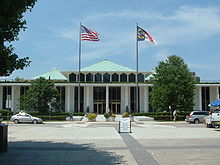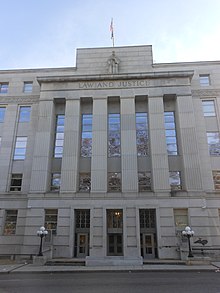Government of North Carolina
Government of North Carolina | |
|---|---|
 | |
| Polity type | Presidential System |
| Constitution | Constitution of North Carolina |
| Legislative branch | |
| Name | General Assembly |
| Type | Bicameral |
| Meeting place | North Carolina State Legislative Building |
| Upper house | |
| Name | Senate |
| Presiding officer | Mark Robinson,President |
| Lower house | |
| Name | House of Representatives |
| Presiding officer | Tim Moore,Speaker |
| Executive branch | |
| Head of Stateand Government | |
| Title | Governor |
| Currently | Roy Cooper |
| Appointer | Election |
| Cabinet | |
| Name | Cabinet |
| Leader | Governor |
| Deputy leader | Lieutenant Governor |
| Headquarters | State Capitol |
| Judicial branch | |
| Name | Judiciary of North Carolina |
| Courts | Courts of North Carolina |
| North Carolina Supreme Court | |
| Chief judge | Paul Martin Newby |
| Seat | Law and Justice Building,Raleigh |
Thegovernment of North Carolinais divided into three branches: executive, legislative, and judicial. These consist of theCouncil of State(led by theGovernor), thebicamerallegislature (called theGeneral Assembly), and the state court system (headed by theNorth Carolina Supreme Court). TheConstitution of North Carolinadelineates the structure and function of the state government.[1][2][3]
Executive branch
[edit]North Carolina's executive branch is governed by Article III of the state constitution. The first North Carolina Constitution in 1776 called for a governor and a seven member Council of State elected by the legislature. Currently, the ten-member Council of State of North Carolina includes the following members elected by voters:[1][2][3][4][5][6]
The Council of State as a collective body is accorded little responsibility by the state constitution, though some statues grant it authority in certain cases, particularly in the acquisition of property by the state.[7]

The nineNorth Carolina Cabinetdepartments, headed by department secretaries, plus the Department of Administration, are appointed by the Governor are as follows:[4]
- Department of Administration,
- Department of Commerce,
- Department of Natural and Cultural Resources,
- Department of Environmental Quality,
- Department of Health and Human Services,
- Department of Information Technology
- Department of Revenue,
- Department of Public Safety,
- Department of Military and Veterans Affairs,[8]
- Department of Transportation.
The North Carolina Register includes information about state agency rules, administrative rules, executive orders and other notices, and is published bimonthly.[9][10]The North Carolina Administrative Code (NCAC) contains all thecodifiedrules.[9]
Legislative branch
[edit]
The legislature derives its authority from Article II of the North Carolina Constitution.[3]TheNorth Carolina General Assemblyis thestate legislature.Like all other states except forNebraska,the legislature isbicameral,currently consisting of the 120-memberNorth Carolina House of Representatives[11]and the 50-memberNorth Carolina Senate.The lieutenant governor is theex officiopresident of the state Senate. The Senate also elects its ownpresident pro temporeand the House elects itsspeaker.Itssession lawsare published in the officialNorth Carolina Session Lawsandcodifiedas theNorth Carolina General Statutes.[9][12][13]
Judiciary
[edit]
North Carolina's current judicial system was created in the 1960s after significant consolidation and reform.[14]The judicial system derives its authority from Article IV of the North Carolina Constitution.[15]Thestate courtsystem is unified into one General Court of Justice.[16]The General Court is composed of aDistrict Court Division,aSuperior Court Division,and an Appellate Division.[17]The Administrative Office of the Courts oversees all clerical and financial aspects of the state judicial system.[16]
At the helm of the General Court of Justice and one of the two components of the Appellate Division is theSupreme Court of North Carolina.[18]The Supreme Court consists of one chief justice and six associate justices, all popularly-elected to serve eight-year terms.[19]The primary function of the tribunal is to decide questions of law that have arisen in the lower courts and before state administrative agencies,[20]and its docket is typically dominated by cases concerning interpretation of the constitution, major legal questions, and appeals of criminal cases involvingcapital punishment.[15]TheNorth Carolina Court of Appealsis the state's intermediateappellate courtand consists of fifteen judges who rule in rotating panels of three. Together, the Supreme Court and Court of Appeals constitute the appellate division of the court system.
The trial division includes the Superior Court and the District Court. The Superior Court is the statetrial courtofgeneral jurisdiction;allfelonycriminal cases, civil cases involving anamount in controversyin excess of $25,000, and appeals from the District Court are tried (de novo review) in Superior Court. Ajuryof 12 hears the criminal cases.
The District Court is a court oflimited jurisdiction.It hasoriginal jurisdictionoverfamily lawmatters (divorce,child custody,child support);civil claimsinvolving less than $25,000; criminal cases involvingmisdemeanorsand lesser infractions; and juvenile cases involving children under the age of 16 who aredelinquentand children under the age of 18 who are undisciplined, dependent, neglected, or abused.Magistratesof the District Court may accept guiltypleasfor minor misdemeanors, accept guilty pleas fortraffic violations,and acceptwaiversof trial forworthless checkand other charges. In civil cases, the magistrate is authorized to try small claims involving up to $10,000 including landlord-tenant andevictioncases. Magistrates also performcivil marriages.District Court only conductsbench trials,with no jury.
Local government
[edit]
Overview
[edit]The General Assembly's authority to create local governments comes from Article VII of theConstitution of North Carolina.[21]Local governments in North Carolina primarily consist of counties, cities, and towns.[22]The state makes no legal distinction between a town and a city.[23]North Carolina has 100 counties and more than 552 municipalities.[24]There are alsospecial purposegovernments, most of which concern either soil and water conservation or housing and community development.[25]Some local governments are joined inregional councilswith others to improve coordination and cooperation.[26]
Counties
[edit]All counties in the state are led by an elected board of commissioners who employ a county manager.[27]Boards of commissioners vary in size from three to 11 members. In addition to the manager, the commissioners usually hire the county's clerk, attorney, assessor, and tax collector. Unlike in municipal council-manager governments in the state, the board of commissioners usually must approve all of the manager's hiring decisions unless they explicitly delegate sole hiring authority to the manager.[28]County government in North Carolina is also more fractured than municipal government, due to the presence of other elected officials such as sheriffs and registers of deeds, who have control over their own staff.[29]The office of county sheriff is established by the constitution, and sheriffs are not subject to the oversight of the state government.[30]County government is largely funded through local property taxes.[31]
County governments in North Carolina include the following officials:[22]
- Sheriffs
- County commissioners
- Register of deeds
- Clerk of court
- Alcoholic Beverage Control Board
- Board of Education
- Board of Elections
- Public Health Board
- Mental Health Board
- Social Services Board
Municipalities
[edit]North Carolina is aDillon's rulestate,[32]and municipalities are only able to exercise the authority that the General Assembly or state constitution explicitly gives them.[24]All municipalities in North Carolina operate under eithermayor-council governmentsorcouncil-manager government,[24]with most using the latter.[23]All have an elected general governing board known variously as a city or town council, the board of commissioners or the board of aldermen.[24]Some of these municipalities have mayors, who preside over the elected city council, which determines local government policy and creates the city budget. Most mayors are popularly elected and do not typically vote in council meetings. The council hires thecity managerand, depending on the municipality, may directly hire a few other officials, such as thecity attorney.In cities with a manager, the manager acts as the head executive officer of the city and is responsible for municipal employees and implementing policy.[33]Smaller municipalities are more likely to not employ a manager.[34]
See also
[edit]References
[edit]- ^ab"North Carolina Constitution of 1776".Yale Law School.1776.RetrievedSeptember 4,2019.
- ^ab"The 1868 constitution".Learn NC.RetrievedMarch 5,2017.
- ^abc"Constitution of North Carolina, 1971".North Carolina General Assembly.
- ^ab"Executive Branch".NCPedia.org.RetrievedSeptember 11,2019.
- ^Marshall, Ellaine F. (2001).North Carolina Manual.North Carolina Secretary of State.
- ^"Article III of the North Carolina State Constitution of 1971".1971.RetrievedSeptember 11,2019.
- ^Orth, John V. (2006)."Council of State".NCPedia.North Carolina Government & Heritage Library.RetrievedAugust 4,2022.
- ^"NC Governor Roy Cooper".governor.nc.gov.Retrieved11 April2018.
- ^abc"N.C. State Statutes, County and Municipal Ordinances".University of North Carolina Kathrine R. Everett Law Library.Archived fromthe originalon 13 April 2014.Retrieved10 April2014.
- ^"North Carolina Register".www.oah.nc.gov.RetrievedDecember 6,2019.
- ^called the House of Commons until 1868 when it was change in the North Carolina Constitution
- ^"North Carolina Government".NC.GOV.RetrievedSeptember 11,2019.
- ^"Session Laws".ncgovdocs.org.Archived fromthe originalon December 6, 2019.RetrievedDecember 6,2019.
- ^Fleer 1994,p. 132.
- ^ab"Judicial Branch".nc.gov.The State of North Carolina.RetrievedMarch 24,2023.
- ^abWilliams, Wiley J. (2006)."Judiciary, State".NCPedia.North Carolina Government & Heritage Library.RetrievedMay 24,2023.
- ^Orth & Newby 2013,p. 128.
- ^Orth & Newby 2013,pp. 130, 133.
- ^Orth & Newby 2013,p. 130, 138.
- ^Brinkley, Martin H."Supreme Court of North Carolina: A Brief History".North Carolina Administrative Office of the Courts. Archived fromthe originalon March 21, 2008.RetrievedJuly 16,2008.
- ^Orth & Newby 2013,pp. 169–170.
- ^abWhittaker, Gordon (June 2012).Local Government in North Carolina(PDF)(4th ed.). Chapel Hill: UNC School of Government and the North Carolina City and County Management Association.Retrieved18 May2019.
- ^abStick, David (2006)."Towns and Cities".NCPedia.North Carolina Government & Heritage Library.RetrievedAugust 4,2022.
- ^abcd"How NC Cities Work".North Carolina League of Municipalities.RetrievedSeptember 22,2023.
- ^Cooper & Knotts 2012,pp. 214–215.
- ^Cooper & Knotts 2012,p. 215.
- ^Cooper & Knotts 2012,pp. 209, 213.
- ^Cooper & Knotts 2012,p. 213.
- ^Cooper & Knotts 2012,pp. 213–214.
- ^Orth & Newby 2013,p. 170.
- ^Nagem, Sarah (July 7, 2022)."Scotland County lowers property tax rate, but it's still the highest in North Carolina".Border Belt Independent.RetrievedJuly 20,2022.
- ^Cooper & Knotts 2012,p. 216.
- ^Cooper & Knotts 2012,pp. 209, 211–212.
- ^Cooper & Knotts 2012,p. 209.
Works cited
[edit]- Cooper, Christopher A.; Knotts, H. Gibbs, eds. (2012).The New Politics of North Carolina.Chapel Hill: University of North Carolina Press.ISBN9781469606583.
- Fleer, Jack D. (1994).North Carolina Government & Politics.Lincoln: University of Nebraska Press.ISBN9780803268852.
- Orth, John V.; Newby, Paul M. (2013).The North Carolina State Constitution(second ed.). Oxford University Press.ISBN9780199300655.
External links
[edit]- "North Carolina Government".NC.gov.RetrievedSeptember 11,2019.
 Media related toGovernment of North Carolinaat Wikimedia Commons
Media related toGovernment of North Carolinaat Wikimedia Commons


